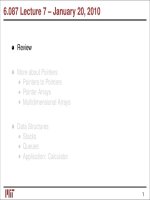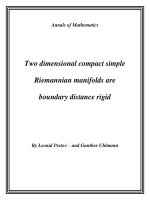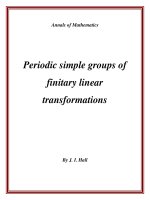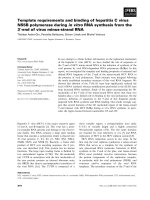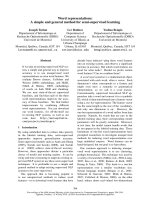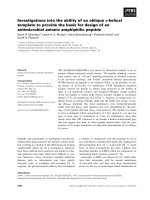Foaw simple outline template
Bạn đang xem bản rút gọn của tài liệu. Xem và tải ngay bản đầy đủ của tài liệu tại đây (89.01 KB, 2 trang )
Music Therapy and Neuroscience
Le Minh Trong
Section #4
I. Introduction
A. Research Question:
• How does neuroscience prove the effectiveness of music therapy in treating mental health
issues?
B. Thesis Statement:
• Neuroscience paints a compelling picture of the intricate dance between music and the
brain, revealing the powerful therapeutic potential of music therapy.
II. Discussion
A. Foundations of Music Therapy
• Music therapists use the unique qualities of music (e.g., melody, rhythm, tempo, dynamics,
pitch) within the therapeutic relationship to access patient's emotions and memories, to
address social experiences, or influence behavior (Wheeler, 2015).
• All structural attributes of music—including tempo, dynamics, timbre, melody, harmony,
tonality, and rhythm—interact with emotional systems, preferences, and aesthetic
appreciation (Thompson et al., 2023).
➢ Music’s unique qualities can be harnessed to address a variety of psychological and
emotional challenges, providing a powerful therapeutic tool for individuals facing various
conditions.
B. Neurological Underpinnings of Music Therapy
• Humans are drawn towards music perceived as pleasant – such as the phenomenon of
chills, where music activates the same dopamine-releasing reward systems involved in
eating, sex, and recreational drug use (Salimpoor, Benovoy, Larcher, Dagher, & Zatorre,
2010).
• Norman-Haignere and colleagues (2015) have identified a specific region of the brain
responding highly selectively to music, rather than only piggybacking brain regions devoted
to non-musical behaviors such as speech, pointing to the potential involvement of this
region or neural population in human evolution.
➢ Music engages a vast symphony of brain regions.
C. Empirical Evidence of Effectiveness
•
Music therapy is well regarded as a holistic treatment appropriate for addressing the
psychosocial and spiritual needs of those with cancer and palliative conditions and their
carers (Running, Shreffler-Grant, & Andrews, 2008)
• Music therapy treatment may be beneficial for improving social skills in children with ASD
(LaGasse, 2017).
• Music listening is strongly associated with stress reduction by the decrease of physiological
arousal as indicated by reduced cortisol levels, lowered heart rate, and decreases in mean
arterial pressure (Martina et al., 2020).
➢ Neuroscience not only illuminates the mechanisms but also provides concrete evidence of
music therapy's impact.
D. Challenges and Future Directions
•
Mainstream neuroscience methods tend towards standardization and replicability,
inappropriate to studying music therapy approaches predicated on personalizing and
tailoring the personal and musical qualities of an intervention to each client (Magee &
Stewart, 2015)
• As Ansdell (2014) pointed out, in researching the effectiveness of music therapy we should
acknowledge its rightful place in social life – its material, social and cultural ecology.
➢ While the field of music therapy research is thriving, challenges remain.
III. Reference List
1. A Blythe LaGasse (2017) Social outcomes in children with autism spectrum disorder: a review
of music therapy outcomes, Patient Related Outcome Measures, 8:, 2332, DOI: 10.2147/PROM.S106267
2. Ansdell, G. (2014). Yes, but, no, but: A contrarian response to Cross (2014). Psychology of
Music, 42(6), 820-825. doi: 10.1177/0305735614544189
3. Martina de Witte, Ana da Silva Pinho, Geert-Jan Stams, Xavier Moonen, Arjan
E.R. Bos & Susan van Hooren (2020) Music therapy for stress reduction: a systematic review
and meta-analysis, Health Psychology Review, 16:1, 134159, DOI: 10.1080/17437199.2020.1846580
4. Norman-Haignere, S., Kanwisher, N. G., & McDermott, J. H. (2015). Distinct cortical pathways
for music and speech revealed by hypothesis-free voxel decomposition. Neuron, 88(6), 12811296. doi: 10.1016/j.neuron.2015.11.035
5. Running, A., Shreffler-Grant, J., & Andrews, W. (2008). A survey of hospices use of
complementary therapy. Journal of Hospice and Palliative Nursing, 10(5), 304-312. doi:
10.1097/01.NJH.0000319177.25294.e5
6. Salimpoor, V. N., Benovoy, M., Larcher, K., Dagher, A., & Zatorre, R. J. (2011). Anatomically
distinct dopamine release during anticipation and experience of peak emotion to music. Nature
Neuroscience, 14(2), 257-262. doi: 10.1038/nn.2726
7. Thompson, W. F., Bullot, N. J., & Margulis, E. H. (2023). The psychological basis of music
appreciation: Structure, self, source.Psychological Review, 130(1), 260–284.
/>8. Wheeler, B. L. (2015). Music therapy handbook. Guilford Publications.
